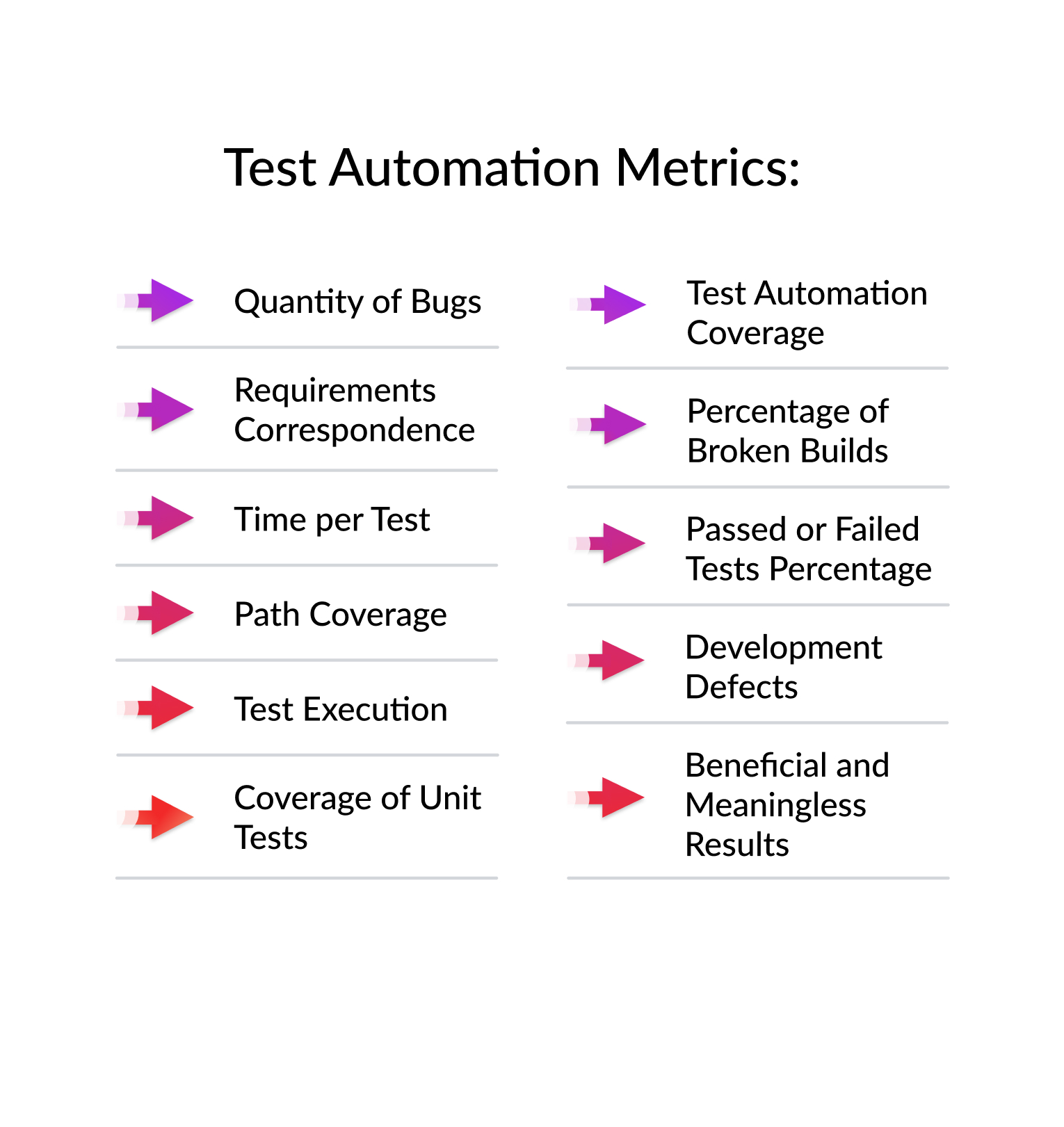Software development teams should assess how and what they test and apply the appropriate test automation metrics if they want to increase the effectiveness of their automated testing.
A practical method to evaluate the return on any investment, identify the test automation elements that are not working, and fix those elements is to use test automation metrics and KPIs.
Automated testing implementation is a process, and any metrics chosen to gauge progress (such as the ratio of human to automated tests) must consider specific characteristics of the business, market, or environment they are utilized in. As a result, there isn’t a set of “universal metrics” that always function in every situation.
Teams at testing projects are fully aware of the effort they expend on a project, but need to be more worn out to consider its results once completed. Let’s examine how to evaluate a software development project.
TEST AUTOMATION Metrics: Advantages and Disadvantages

Requirements Correspondence
The tested components corresponding to a particular requirement or user narrative are both described by this automated test metric.
Advantage: This test measuring metric tracks the fulfillment of the client’s requirements and whether tests consider those aspects. It provides information on each run conducted.
Disadvantage: A test examining one requirement can only check specific components. Because of this, the estimation of such a test is low, demonstrating a drawback of automation testing.
Quantity of Bugs
This test automation measure determines the defects encountered during the test execution phase.
Advantage: The number of flaws found is a fundamental indicator of how poor a product is compared to previous deployments. This enables us to assess the quality of current deliveries and previously used products. In addition, the defects found under particular circumstances change consistently.
Disadvantage: A testing team that receives compensation based on this statistic can identify many low-priority bugs.
Time per Test
Advantage: The test time evaluation is an essential component of testing, since it specifies the actions a test team should take and the resources that should be invested. The agile methodology’s primary metric is performance.
Disadvantage: exhaustible testing is impossible
Path Coverage
Advantage: Testing for path coverage must be exceedingly thorough, which enhances the testing process. The software runs each iteration only once, including the entire path. Every program description is run with complete path coverage.
Disadvantage: The diversity of approaches increases with the number of branches and consumes time.
Test Execution
This metric displays all test runs as part of a build.
Advantage: Test execution is a crucial automation criterion to determine when automated tests are complete and successful.
Disadvantage: Since tests might produce false positives and negatives, the fact that a certain percentage of tests passed does not guarantee high-quality service.
Coverage of Unit Tests
This measure represents the total number of unit tests run to determine whether the entire code was tested.
Advantage: Unit test coverage clearly shows the software’s codebase is well-written. It allows metrics automation.
Disadvantage: Only a single element is tested during a unit test. For instance, unit test inclusion ignores integration tests essential to ensuring the code is functional.
Test Automation Coverage
The amount of automated tests that have been run is displayed in rate, comparison, and full test coverage.
Advantage: Like the majority of measuring automation metrics, this one illustrates the testing process and the machine’s usability.
Disadvantage: Occasionally, automation must catch up on flaws that manual testing can fix.
Percentage of Broken Builds
Automated tests may ultimately fail and wreck a build. This test automation statistic displays the broken builds due to poor coding quality and failed tests.
Advantage: This measure reveals the actual quality of the code, and if the percentage of broken builds is decreasing, Experts are becoming more dependable when dealing with codebase modifications.
Disadvantage: Focusing on the detected broken builds rather than the test tasks and their general direction.
Passed or Failed Tests Percentage
Advantage: Counting the tests that failed or passed provides an overview of testing progress. One option is to create a visual chart that displays the succeeded, failed, and unrun tests. This gives you an opportunity to keep track of how the testing is going.
Disadvantage: The product may function differently than intended, even if a test passes because it just tests a small requirement, or the code might need to be revised.
Development Defects
Advantage: This automation test metric enables us to adjust testing in response to emerging concerns and prevent similar issues in the future.
Disadvantage: Only some of the problems that were found may be flaws. It is wiser to identify deficiencies before the release than after.
Beneficial and Meaningless Results
This test automation measure compares significant results from automated tests versus irrelevant results.
Advantage: From an economic perspective, irrelevant outcomes reduce automation’s productivity. Comparing a valuable result to one irrelevant is made simple regarding a specified suitable level.
Disadvantage: This test automation measure cannot reveal software quality. It gives you information on tests rather than on the quality of the software.
Automated Tests Metrics: Wrapping Up
This article provided a few examples of the numerous potential automated test metrics. Metrics are crucial for monitoring and comprehending test automation; each paints an incomplete and occasionally false picture. They give testers a break from actual testing and its impact on product discharge. It is essential to use the correct measure for the proper test to monitor adequately.
Choosing the best-automated testing tools and considering meaningful testing metrics is essential. The positive rate in these measures demonstrates that your testing is progressing as planned, which may result from team members’ proper skill levels and the efficiency of testing frameworks and scripts.
Faster testing processes necessitate more extensive testing metrics, which help the QA team identify defects and the development team correct them and make the necessary improvements, leading to higher-quality apps.
Quintagroup is dedicated to offering the best testing process by hiring knowledgeable QA engineers in the team and selecting the proper metrics to deliver the approved software on schedule. Get a consultation.
